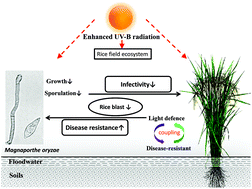当前位置:
X-MOL 学术
›
Photochem. Photobiol. Sci.
›
论文详情
Our official English website, www.x-mol.net, welcomes your
feedback! (Note: you will need to create a separate account there.)
Effects of UV-B radiation on the infectivity of Magnaporthe oryzae and rice disease-resistant physiology in Yuanyang terraces
Photochemical & Photobiological Sciences ( IF 2.7 ) Pub Date : 2017-10-13 00:00:00 , DOI: 10.1039/c7pp00139h Xiang Li 1, 2, 3, 4 , Yongmei He 1, 2, 3, 4 , Chunmei Xie 1, 2, 3, 4 , Yanqun Zu 1, 2, 3, 4 , Fangdong Zhan 1, 2, 3, 4 , Xinyue Mei 1, 2, 3, 4 , Yang Xia 1, 2, 3, 4 , Yuan Li 1, 2, 3, 4
Photochemical & Photobiological Sciences ( IF 2.7 ) Pub Date : 2017-10-13 00:00:00 , DOI: 10.1039/c7pp00139h Xiang Li 1, 2, 3, 4 , Yongmei He 1, 2, 3, 4 , Chunmei Xie 1, 2, 3, 4 , Yanqun Zu 1, 2, 3, 4 , Fangdong Zhan 1, 2, 3, 4 , Xinyue Mei 1, 2, 3, 4 , Yang Xia 1, 2, 3, 4 , Yuan Li 1, 2, 3, 4
Affiliation

|
The traditional rice variety “Baijiaolaojing” was planted in Yuanyang terraces (1600 m altitude) under field conditions. The effects of enhanced UV-B radiation (0 kJ m−2, 2.5 kJ m−2, 5.0 kJ m−2 and 7.5 kJ m−2) on the rice–Magnaporthe oryzae system were studied with respect to the Magnaporthe oryzae infection, the disease-resistance physiology of the rice and the rice blast disease condition. The results showed that under enhanced UV-B radiation, the infectivity of Magnaporthe oryzae was decreased, which could significantly inhibit its growth and sporulation. The activities of rice leaf disease-resistance-related enzymes (phenylalanine ammonia-lyase, lipoxygenase, chitinase and β-1,3-glucanase) were significantly increased under enhanced UV-B radiation. Following inoculation with Magnaporthe oryzae, levels of disease-resistance-related substances in the rice leaves were significantly increased. Among the results, it was found that leaves after UV-B radiation had a more significant resistance response. The level of UV-B irradiation showed a parabolic relationship with the rice blast index (r2 = 0.85, P < 0.01; in the control group, r2 = 0.88, P < 0.01). The disease index decreased with increase in irradiation. The DI was at a minimum with enhanced UV-B irradiance of 4 kJ m−2; thereafter, it increased with increasing irradiation. The enhanced UV-B radiation had a direct impact on the growth of rice and Magnaporthe oryzae, and it indirectly changed the rice–Magnaporthe oryzae system. UV-B radiation could reduce the harmful impact of rice blast.
中文翻译:

UV-B辐射对元阳梯田稻瘟病菌感染性及水稻抗病生理的影响
在田间条件下,在Yuan阳梯田(海拔1600 m)种植了传统的水稻品种“白椒老净”。增强UV-B辐射的(0千焦米的影响-2,2.5千焦耳米-2,5.0千焦耳米-2和7.5千焦耳米-2)的米通上稻瘟病菌系统进行了研究关于稻瘟病菌感染,水稻的抗病生理和稻瘟病病情。结果表明,在增强的UV-B辐射下,稻瘟病菌的感染性减少,这可能会大大抑制其生长和孢子形成。在增强的UV-B辐射下,水稻叶片抗病相关酶(苯丙氨酸氨解酶,脂氧合酶,几丁质酶和β-1,3-葡聚糖酶)的活性显着增加。稻瘟病菌接种后,稻叶中抗病相关物质的含量显着增加。在这些结果中,发现UV-B辐射后的叶子具有更显着的电阻响应。UV-B辐射水平与稻瘟病指数呈抛物线关系(r 2 = 0.85,P <0.01;对照组,r 2 = 0.88,P<0.01)。疾病指数随着辐射的增加而降低。DI最小,UV-B辐射增强到4 kJ m -2;此后,它随着辐照的增加而增加。增强的UV-B辐射直接影响水稻和稻瘟病菌的生长,并间接改变了稻-稻瘟病菌的系统。UV-B辐射可以减少稻瘟病的有害影响。
更新日期:2017-10-13
中文翻译:

UV-B辐射对元阳梯田稻瘟病菌感染性及水稻抗病生理的影响
在田间条件下,在Yuan阳梯田(海拔1600 m)种植了传统的水稻品种“白椒老净”。增强UV-B辐射的(0千焦米的影响-2,2.5千焦耳米-2,5.0千焦耳米-2和7.5千焦耳米-2)的米通上稻瘟病菌系统进行了研究关于稻瘟病菌感染,水稻的抗病生理和稻瘟病病情。结果表明,在增强的UV-B辐射下,稻瘟病菌的感染性减少,这可能会大大抑制其生长和孢子形成。在增强的UV-B辐射下,水稻叶片抗病相关酶(苯丙氨酸氨解酶,脂氧合酶,几丁质酶和β-1,3-葡聚糖酶)的活性显着增加。稻瘟病菌接种后,稻叶中抗病相关物质的含量显着增加。在这些结果中,发现UV-B辐射后的叶子具有更显着的电阻响应。UV-B辐射水平与稻瘟病指数呈抛物线关系(r 2 = 0.85,P <0.01;对照组,r 2 = 0.88,P<0.01)。疾病指数随着辐射的增加而降低。DI最小,UV-B辐射增强到4 kJ m -2;此后,它随着辐照的增加而增加。增强的UV-B辐射直接影响水稻和稻瘟病菌的生长,并间接改变了稻-稻瘟病菌的系统。UV-B辐射可以减少稻瘟病的有害影响。











































 京公网安备 11010802027423号
京公网安备 11010802027423号